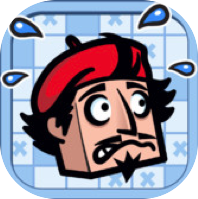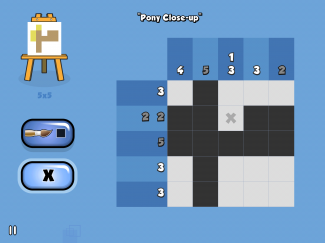Bastion
LQ: 9.15
Recommended Age: 10+
Skills Used: Planning, Working Memory, Mathematics, Reading

Paint it Back is an excellent logic-based puzzle game, with picross-style challenges. In the game, there’s been some trouble in the art gallery – as it appears a clumsy ghost has accidentally frightened all of the paintings away! The player’s brain-teasing journey begins with a gallery full of blank canvases. The game provides canvases (grids) of various sizes (as small as 5×5 but even bigger than 16×20!) and the player must paint back the artwork using logic and deduction, filling in one square at a time. Thankfully, each row and column provide assistance by indicating the number of consecutive colored squares that need painting – so all the player has to do is figure out which squares to paint! Using these clues is the only way to save the upcoming exhibition and ensure a gallery full of well-done artwork! The puzzles range from very easy to quite challenging, so although players as young as six could play many of the simpler puzzles, some of the later challenges may require assistance.
Teachers: Check out the Classroom Guide!
Developing a systematic approach for setting and achieving goals.
 If there is one thing Paint it Back stresses to the player, it's to NOT guess! Meaning, the best way to play and win is to think about what you're going to do and to be sure it's the right decision, before your finger even touches screen. Every step is calculated with logic - primarily using the method of deduction. The numbers corresponding to the columns and rows tell the player how many squares need to be painted, but he will only know which ones to paint by using clues and logic. Deducing the "answers" in the game is easily done with a step-by-step method that can be applied to all of the puzzles. The first step is to look for the large numbers that completely, or almost completely, fill up a row or column. Then, the player can start to notice any "definites" or "absolute nots" in terms of which grids need color. He can begin placing "x"s wherever he knows an empty square will be, which further helps him deduce which squares need paint. The challenge the puzzle poses to him varies depending on the size of the grid - however this strategy is applicable (and maybe even necessary) to finishing each and every canvas. Although he is not penalized for incorrect selections, it becomes extremely difficult to finish a puzzle once a wrong selection has been made - to the point where it's generally easier to restart the level than to backtrack where the mistake occurred. Tapping into Planning skills to evaluate the grid, remaining numbers, and empty squares, is the smartest, most efficient way to win. Painting without Planning is more likely to end up with a canvas of indiscernible art, which is in no way suitable for the upcoming gallery exhibition!
If there is one thing Paint it Back stresses to the player, it's to NOT guess! Meaning, the best way to play and win is to think about what you're going to do and to be sure it's the right decision, before your finger even touches screen. Every step is calculated with logic - primarily using the method of deduction. The numbers corresponding to the columns and rows tell the player how many squares need to be painted, but he will only know which ones to paint by using clues and logic. Deducing the "answers" in the game is easily done with a step-by-step method that can be applied to all of the puzzles. The first step is to look for the large numbers that completely, or almost completely, fill up a row or column. Then, the player can start to notice any "definites" or "absolute nots" in terms of which grids need color. He can begin placing "x"s wherever he knows an empty square will be, which further helps him deduce which squares need paint. The challenge the puzzle poses to him varies depending on the size of the grid - however this strategy is applicable (and maybe even necessary) to finishing each and every canvas. Although he is not penalized for incorrect selections, it becomes extremely difficult to finish a puzzle once a wrong selection has been made - to the point where it's generally easier to restart the level than to backtrack where the mistake occurred. Tapping into Planning skills to evaluate the grid, remaining numbers, and empty squares, is the smartest, most efficient way to win. Painting without Planning is more likely to end up with a canvas of indiscernible art, which is in no way suitable for the upcoming gallery exhibition!
Getting started and then maintaining attention and effort to tasks.
Although Paint it Back is an enjoyable and rewarding puzzle game, it isn't exactly overly exciting or stimulating. This means that on the larger and harder grids, the pure desire for achievement and forward progress in the game are the primary motivators in actually powering through the lengthy puzzles. In other words: goal-directed persistence is a big factor in whether or not a player finishes the tougher canvases. He must be invested enough to want to earn the ribbon that he doesn't mind (or ignores the fact) that solving the puzzle isn't the most exciting thing he's ever done. A weak interest in unlocking new galleries and painting bigger, better art will not get him very far in the game, as he will quickly give up on the larger paintings. Determining that he wants to do well, doing what it takes to make it happen, and then appreciating the connection between his efforts and his subsequent accomplishment(s), is an excellent way to use and strengthen his Focus skills.
All membership plans come with full access to our entire suite of tools learning guides, and resources. Here are a few of the ones we think you’ll like the most: